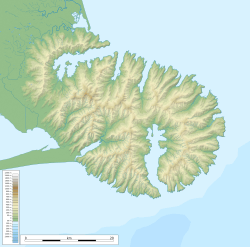Ōtamahua / Quail Island facts for kids
|
Ōtamahua (Māori)
|
|
|---|---|

View of Ōtamahua / Quail Island
|
|
| Geography | |
| Coordinates | 43°38′S 172°41′E / 43.63°S 172.69°E |
| Area | 0.8 km2 (0.31 sq mi) |
| Highest elevation | 86 m (282 ft) |
| Administration | |
| Demographics | |
| Population | 0 |
Ōtamahua / Quail Island (Māori: Ōtamahua or Te Kawakawa) is an 81-hectare island in Lyttelton Harbour / Whakaraupō, near Christchurch, New Zealand. No one lives on the island today.
Captain William Mein Smith gave the island its European name in 1842. He saw native quail there, but these birds were already extinct by 1875. The Māori name Ōtamahua means 'the place where children collect sea eggs'. Te Kawakawa refers to the pepper trees found on the island.
Contents
History of Ōtamahua / Quail Island
Early Māori Visits
Even though no one lived on Ōtamahua, Māori people often visited the island. They came to gather shellfish, flax, and bird's eggs. They also collected stone for tools from Aua / King Billy Island, a small rock nearby.
In 2019, a 9-meter-tall pou whenua (a carved pillar) was put up on the island. This pillar, named Te Hamo o Tū Te Rakiwhānoa, shows how important the island was for gathering food for Te Hapū o Ngāti Wheke, a local Māori group. A hamo was a tool used for planting kūmara (sweet potatoes).
Quarantine Station and Leper Colony
In 1851, Europeans briefly farmed on the island. Later, in 1875, it became a quarantine station. This meant people or animals who might have diseases were kept there to stop the spread of illness.
The island also served as a hospital during an influenza outbreak in 1907. From 1906 to 1925, it was a small place where people with leprosy lived. Fourteen men were sent there, and two of them passed away on the island.
One patient, Ivon Skelton, arrived in 1919. He was from Samoa and was diagnosed with leprosy while visiting New Zealand. He died on the island in 1923 at age 24 and was buried there. In 2015, people tried to move his body because of erosion, but they only found a pot and a bowl.
Another patient, Sam Te Iringa, tried to organize a "strike" because the living conditions were poor. However, since the patients didn't do any work, the strike didn't change much. He died in 1922.
Some patients managed to leave the island. George Phillips walked off at low tide in 1925 and started a new life in another town. Other patients included Jim Lord, Jim Kokiri, and Will Vallance. In 1925, the last eight patients were moved to another colony. The buildings on the island were later taken down.
Animals on the Island
Animals were also quarantined on the island, but separately from the people. These animals included huskies, mules, and ponies. They were being prepared for famous Antarctic expeditions led by explorers like Robert Falcon Scott and Ernest Shackleton.
Some of the expeditions that used Quail Island were:
- The Discovery Expedition (1901–04)
- The Nimrod Expedition (1907–09)
- The Terra Nova Expedition (1910–13)
- The Byrd Antarctic Expedition (1928–30)
Today, you can see replicas of the dog kennels and a patient's hut on the island. The old quarantine barracks have also been restored and moved closer to the beach.
Ecological Restoration Efforts
In 1975, the island became a recreation reserve. Before that, it was a working farm where sheep and potatoes were raised until the late 1970s.
The Ōtamahua/Quail Island Ecological Restoration Trust and the Department of Conservation are working hard to bring the island back to its natural state. Their goal is to remove harmful pests and plant native trees and plants. This will create a safe home for native animals that are rare or have disappeared from the area.
Volunteers have changed large parts of the island. What was once dry and full of pests is now a safe place for native plants and animals. This project is special because it balances allowing people to visit and enjoy the island with restoring its natural environment.
They have also set up nesting boxes for the white-flippered penguin. This penguin is an endangered native bird of the Banks Peninsula. Volunteers work regularly to control pests and weeds. Every spring, they have a big planting event.
Since 1997, volunteers have successfully removed rabbits, cats, hedgehogs, and ship rats from the island. They also have traps on the mainland to stop pests from coming back.
The Trust's volunteers have planted over 95,000 native trees and shrubs. They have also started a nursery to grow silver tussock grass. Because of their efforts, many birds, insects, and rare plants have been brought back to the island.
Some of the animals and plants reintroduced include:
- Korimako (bellbirds)
- Kererū (New Zealand pigeons)
- Lepidium aegrum (Banks Peninsula scurvy grass), a very rare plant
- Banks Peninsula ground beetle (Megadromus guerinii)
- Banks Peninsula tree weta (Hemideina ricta)
- Leaf-vein slug (Pseudaneitea maculata)
Visiting Ōtamahua / Quail Island
About 16,000 people visit Ōtamahua / Quail Island each year. It is the only large island in the Canterbury area that is open to the public.
The island has safe swimming beaches and facilities like toilets and a day shelter. You can get to the island by ferry or by your own private watercraft.
The Ōtamahua/Quail Island Ecological Restoration Trust encourages schools and groups to visit. They can learn about the island's nature and history while enjoying outdoor activities.
It is even possible to stay overnight on the island! The Caretakers House has two bunkrooms with 12 beds. You can book it through the Department of Conservation website.
Images for kids
See also
 In Spanish: Isla Quail para niños
In Spanish: Isla Quail para niños






